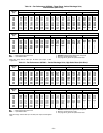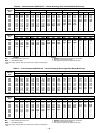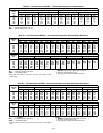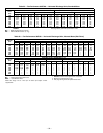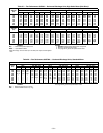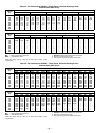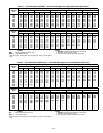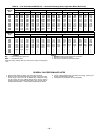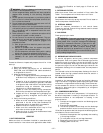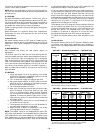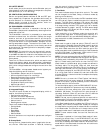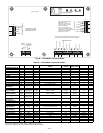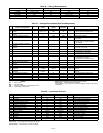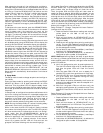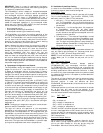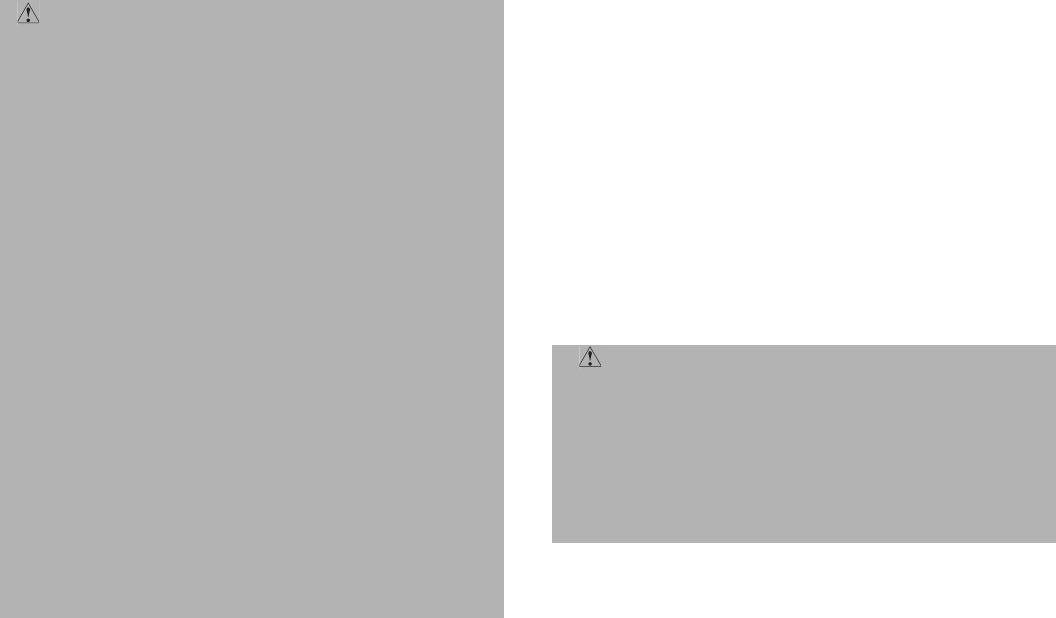
—37—
PRE-START-UP
Proceed as follows to inspect and prepare the unit for initial
start-up:
1. Remove all access panels.
2. Read and follow instructions on all WARNING,
CAUTION, and INFORMATION labels attached to,
or shipped with, the unit.
3. Make the following inspections:
a. Inspect for shipping and handling damages such
as broken lines, loose parts, or disconnected wires,
etc.
b. Inspect for oil at all refrigerant tubing connections
and on unit base. Detecting oil generally indicates
a refrigerant leak. Leak-test all refrigerant tubing
connections using an electronic leak detector,
halide torch, or liquid-soap solution.
c. Inspect all field- and factory-wiring connections.
Be sure that connections are completed and tight.
d. Inspect coil fins. If damaged during shipping and
handling, carefully straighten the fins with a fin
comb.
4. Verify the following conditions:
a. Make sure that condenser fan blade is correctly
positioned in the fan orifice. See Condenser-Fan
Adjustment section on page 48 for more details.
b. Make sure that air filter(s) is in place.
c. Make sure that condensate drain trap is filled
with water to ensure proper drainage.
d. Make sure that all tools and miscellaneous loose
parts have been removed.
START-UP
I. UNIT PREPARATION
Make sure that unit has been installed in accordance with
these installation instructions and applicable codes. Make
sure Start-Up Checklist on back page is filled out and
completed.
II. RETURN-AIR FILTERS
Make sure correct filters are installed in filter tracks. See
Table 1. Do not operate unit without return-air filters.
III. COMPRESSOR MOUNTING
Compressors are internally spring mounted. Do not loosen or
remove compressor holddown bolts.
IV INTERNAL WIRING
Check all electrical connections in unit control boxes.
Tighten as required. Ensure wiring does not come in contact
with refrigerant tubing.
V. GAS PIPING
Check gas piping for leaks.
VI. REFRIGERANT SERVICE PORTS
To service refrigerant service ports, remove compressor
access panel. Each unit system has 4 Schrader-type service
gage ports: one on the suction line, one on the liquid line, and
two on the compressor discharge line. Be sure that caps on
the ports are tight. One of the Schrader-type valves on the
compressor discharge line is located under the low-pressure
switch.
The Schrader valve on the compressor discharge line that is
located under the high pressure switch does not contain a
Schrader core in the valve.
VII. HIGH FLOW VALVES
Located on the compressor hot gas and suction tubes are
High Flow Valves. Large black plastic caps distinguish these
valves with o-rings located inside the caps. These valves can-
not be accessed for service in the field. Ensure the plastic
caps are in place and tight or the possibility of refrigerant
leakage could occur.
VIII. COMPRESSOR ROTATION
On 3-phase units with scroll compressors, it is important to
be certain compressor is rotating in the proper direction. To
determine whether or not compressor is rotating in the
proper direction:
1. Connect service gages to suction and discharge pres-
sure fittings.
2. Energize the compressor.
3. The suction pressure should drop and the discharge
pressure should rise, as is normal on any start-up.
If the suction pressure does not drop and the discharge pres-
sure does not rise to normal levels:
1. Note that the evaporator fan is probably also rotating
in the wrong direction.
2. Turn off power to the unit and tag disconnect.
3. Reverse any two of the unit power leads.
4. Reapply power to the unit.
WARNING: Failure to observe the following warnings
could result in serious personal injury.
1. Follow recognized safety practices and wear protective
goggles when checking or the servicing refrigerant
system.
2. Do not operate the compressor or provide any electric
power to the unit unless the compressor terminal cov-
er is in place and secured.
3. Do not remove the compressor terminal cover until all
electrical sources are disconnected.
4. Relieve all pressure from the system before touching
or disturbing anything inside the compressor terminal
box if refrigerant leak is suspected around the com-
pressor terminals.
5. Never attempt to repair a soldered connection while
the refrigerant system is under pressure.
6. Do not use torch to remove any component. The sys-
tem contains oil and refrigerant under pressure. To re-
move a component, wear protective goggles and
proceed as follows:
a. Shut off gas and then electrical power to the unit.
Install lockout tag.
b. Relieve all pressure from the system using both
high-pressure and low-pressure ports.
c. Cut the component connection tubing with a tubing
cutter, and remove the component from the unit.
d. Carefully unsweat the remaining tubing stubs when
necessary. Oil can ignite when exposed to torch
flame.
WARNING: Disconnect gas piping from unit when
leak testing at pressure greater than
1
/
2
psig. Pres-
sures greater than
1
/
2
psig will cause gas valve damage
resulting in hazardous condition. If gas valve is sub-
jected to pressure greater than
1
/
2
psig, it must be
replaced before use. When pressure testing field-
supplied gas piping at pressures of
1
/
2
psig or less, a
unit connected to such piping must be isolated by man-
ually closing the gas valve.



